31st Tactical Reconnaissance Training Squadron
31st Tactical Reconnaissance Training Squadron
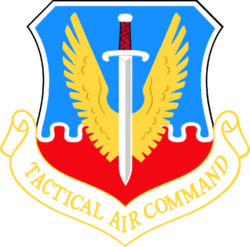 | |
|---|---|
|
31st Fighter Interceptor Squadron F-102A Delta Dagger 56-1294 at Elmendorf AFB, Alaska | |
| Active | 1939–1944; 1944-1946; 1953-1955; 1956-1958; 1969-1971 |
| Country |
|
| Branch |
|
| Role | Reconnaissance Training |
| Insignia | |
| 31st Tactical Reconnaissance Training Squadron Patch |
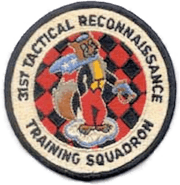 |
The 31st Tactical Reconnaissance Training Squadron is an inactive United States Air Force unit. Its last assignment was with 363d Tactical Reconnaissance Wing at Shaw Air Force Base, South Carolina, where it was inactivated on 18 February 1971.
The squadron was first activated as the 31st Pursuit Squadron for the air defense of the Panama Canal shortly before the United States entered World War II. It served in this role until 1944 when the reduced threat to the canal and the Caribbean permitted its transfer to the United States, where it was inactivated.
The squadron was reactivated a few months later as an element of the 412th Fighter Group, the first Army Air Forces unit equipped with jet fighters. It was inactivated in 1946 when the 412th group and its squadrons were replaced by elements of the 1st Fighter Group.
In 1953, the squadron was activated as the 31st Fighter-Interceptor Squadron, an air defense unit in the Pacific northwest. It was inactivated two years later in a major realignment ot Air Defense Command fighter unit designations. It was again active in the air defense role from 1956 to 1958 in Michigan and Alaska.
Its last active period was as a tactical reconnaissance training unit for RF-4C Phantom II aircrews from 1969 to 1971,
History
World War II
Defense of the Panama Canal
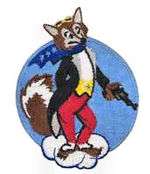

The squadron was constituted in 1939 as the 31st Pursuit Squadron and activated on 1 February 1940 at Albrook Field, Panama Canal Zone[1] as one of the original squadrons of the 37th Pursuit Group.[2] The unit was part of the build-up of the Canal Zone's defenses as war approached. It was initially equipped with a mixture of second-line pursuit aircraft, including Boeing P-26A Peashooters, Northrup A-17 Nomads, and some North American BC-1s. The mission of the squadron was air defense of the Panama Canal. In July 1941, the Squadron started re-equipping with new Curtiss P-40 Warhawks. The Squadron was briefly moved to Rio Hato Field on 5 October 1940 and, following a month there, returned to Albrook on 13 November, where it remained until 24 November 1941.[1]
After the Japanese Attack on Pearl Harbor, the Squadron was moved to La Chorrera Army Airfield where it shared the field with the 30th Pursuit Squadron. The unit operated as an element of the Panama Interceptor Command. On 15 May 1942, the squadron's designation was changed to 31st Fighter Squadron.[1] In September 1942, the unit moved from Albrook to Howard Field and started to convert to Bell P-39 Airacobras. In December, "E" Flight was moved to San Jose Airport, Costa Rica where it was almost immediately reassigned to the 53d Fighter Squadron.
The unit served out the remainder of its Panama tour at several airfields until April 1944, and was moved to the United States as Sixth Air Force eliminated or transferred combat units in view of the reduced threat to the Panama Canal and Caribbean. The squadron was to become a single-engine fighter Replacement Training Unit for Second Air Force at Lincoln Army Airfield, Nebraska, but it was inactivated seven weeks after it arrived at Lincoln.[1]
First Jet Fighters
The squadron was activated once again as part of the 412th Fighter Group, which was located at Muroc Army Airfield, California in August 1944.[1] It became a testing unit for the Bell P-59 Airacomet and Lockheed P-80 Shooting Star jet aircraft under Fourth Air Force. The squadron served in a training role for transitioning pilots from piston-engine to jet engine fighters. The squadron provided Army Air Forces pilots and ground crews with valuable data about the difficulties and pitfalls involved in converting to jet aircraft. This information proved quite useful when more advanced jet fighters finally became available in quantity. The squadron was inactivated in July 1946[1] and its mission, personnel, and equipment were transferred to the 71st Fighter Squadron[3] as the AAF replaced the 412th with the 1st Fighter Group.
Air Defense
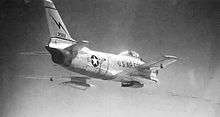
The squadron was reactivated as the 31st Fighter-Interceptor Squadron, an element Air Defense Command at Larson Air Force Base, Washington in early 1953 and assigned to the 4702d Defense Wing.[1] At Larson the squadron was equipped with Mighty Mouse rocket armed and airborne intercept radar equipped North American F-86D Sabre interceptors.[4] The squadron was engaged in the air defense of the Pacific Northwest. In the summer of 1955 ADC implemented Project Arrow, which was designed to bring back on the active list the fighter units which had compiled memorable records in the two world wars and associate them with their traditional headquarters.[5] As a result, the mission, personnel and equipment of the 31st were transferred to the 322d Fighter-Interceptor Squadron IAW ADC "Project Arrow".[1]

The squadron was again reactivated in 1956 at Wurtsmith AFB, Michigan[1] and equipped with supersonic Convair F-102 Delta Daggers armed with the AIM-4 Falcon missile.[4] The following year it moved to Elmendorf AFB, Alaska Territory where it performed intercepts of intruding aircraft as part of Alaskan Air Command, arriving in Alaska. The squadron was inactivated in October 1958[1] and its aircraft were reassigned to the 317th Fighter Interceptor Squadron.
Reconnaissance Training
The 31st was redesignated as the 31st Tactical Reconnaissance Training Squadron and reactivated under Tactical Air Command (TAC) at Shaw AFB, South Carolina in 1969, where it assumed the mission, personnel and equipment of 4414th Combat Crew Training Squadron, which was discontinued. This was part of TAC's program to replace its Major Command controlled (MAJCON)units with USAF controlled (AFCON) units that were able to carry a permanent lineage and history.[6] The squadron conducted RF-4C Phantom II training for tactical reconnaissance aircrews. The squadron was inactivated in 1971 due to reduced training requirements, and its aircraft assigned to the 33d Tactical Reconnaissance Training Squadron.
Lineage
- Constituted as the 31st Pursuit Squadron (Interceptor) on 22 December 1939
- Activated on 1 February 1940
- Redesignated 31st Fighter Squadron (Single Engine) on 15 May 1942
- Inactivated on 25 May 1944
- Activated on 19 August 1944
- Inactivated on 3 July 1946
- Redesignated 31st Fighter-Interceptor Squadron on 11 February 1953.
- Activated on 20 April 1953
- Inactivated on 18 August 1955
- Activated on 8 June 1956
- Inactivated on 8 October 1958[7]
- Redesignated 31st Tactical Reconnaissance Training Squadron and activated on 15 October 1969 (not organized)
- Organized on 15 October 1969
- Inactivated on 18 February 1971
Assignments
- 37th Pursuit (later Fighter) Group, 1 February 1940
- XXVI Fighter Command, 1 November 1943
- Second Air Force, 8 April – 25 May 1944
- 412th Fighter Group, 19 August 1944 – 3 July 1946
- 4702d Defense Wing, 20 April 1953
- 9th Air Division, 8 October 1954 – 18 August 1955
- 412th Fighter Group, 8 June 1956
- 10th Air Division, 20 August 1957 – 8 October 1958[7]
- 363d Tactical Reconnaissance Wing, 16 October 1969 – 18 February 1971
Stations
|
|
Aircraft
|
|
References
Notes
- 1 2 3 4 5 6 7 8 9 10 11 Maurer, Maurer, ed. (1982) [1969]. Combat Squadrons of the Air Force, World War II (PDF) (reprint ed.). Washington, DC: Office of Air Force History. p. 33. ISBN 0-405-12194-6. LCCN 70605402. OCLC 72556.
- ↑ Maurer, Maurer, ed. (1983) [1961]. Air Force Combat Units of World War II (PDF) (reprint ed.). Washington, DC: Office of Air Force History. pp. 137–138. ISBN 0-912799-02-1. LCCN 61060979.
- ↑ Maurer, Combat Squadrons, p. 99
- 1 2 Cornett, Lloyd H; Johnson, Mildred W (1980). A Handbook of Aerospace Defense Organization, 1946–1980 (PDF). Peterson AFB, CO: Office of History, Aerospace Defense Center. p. 118.
- ↑ Buss, Lydus H.(ed), Sturm, Thomas A., Volan, Denys, and McMullen, Richard F., History of Continental Air Defense Command and Air Defense Command July to December 1955, Directorate of Historical Services, Air Defense Command, Ent AFB, CO, 1956, p.6
- ↑ MAJCON units could not carry a permanent history or lineage. -Ravenstein, Charles A. (1984). A Guide to Air Force Lineage and Honors (2d, Revised ed.). Maxwell AFB, AL: USAF Historical Research Center. p. 12.
- 1 2 3 4 Lineage, including assignments, stations, and aircraft through 1958 in Maurer, Combat Squadrons, p. 33
Bibliography
![]() This article incorporates public domain material from the Air Force Historical Research Agency website http://www.afhra.af.mil/.
This article incorporates public domain material from the Air Force Historical Research Agency website http://www.afhra.af.mil/.
- Buss, Lydus H.(ed), Sturm, Thomas A., Volan, Denys, and McMullen, Richard F., History of Continental Air Defense Command and Air Defense Command July to December 1955, Directorate of Historical Services, Air Defense Command, Ent AFB, CO, 1956
- Cornett, Lloyd H; Johnson, Mildred W (1980). A Handbook of Aerospace Defense Organization, 1946–1980 (PDF). Peterson AFB, CO: Office of History, Aerospace Defense Center.
- Maurer, Maurer, ed. (1983) [1961]. Air Force Combat Units of World War II (PDF) (reprint ed.). Washington, DC: Office of Air Force History. pp. 137–138. ISBN 0-912799-02-1. LCCN 61060979.
- Maurer, Maurer, ed. (1982) [1969]. Combat Squadrons of the Air Force, World War II (PDF) (reprint ed.). Washington, DC: Office of Air Force History. ISBN 0-405-12194-6. LCCN 70605402. OCLC 72556.
- Ravenstein, Charles A. (1984). A Guide to Air Force Lineage and Honors (2d, Revised ed.). Maxwell AFB, AL: USAF Historical Research Center.
Further reading
- Hagdedorn, Dan (1995), Alae Supra Canalem: Wings Over the Canal, Turner Publishing, ISBN 1563111535
- Leonard, Barry (2009). History of Strategic Air and Ballistic Missile Defense (PDF). Vol I. 1945-1955. Fort McNair, DC: Center for Military History. ISBN 978-1-4379-2131-1.
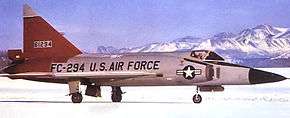

.jpg)